The new administrative location of the Stadtwerke (municipal utility), in the town of Neustadt in Holstein in Germany is setting standards for the municipal energy transition. The new building does not just meet the standard of a zero-emissions passive house, it also incorporates recycled components consistent with the principles of a circular economy. A showcase project that won an award in the “EnEff.Gebäude.2050” ideas competition.
Neustadt in Holstein is proud of its 775-year history and was once a major port city in the Bay of Lübeck. Beautiful old houses grace the small town on the Baltic coast. The former administrative office of the Neustadt Stadtwerke was certainly never one of them. The unattractive building from the 1960s was ready to be demolished in 2014 and plans for the construction of a new building were laid. Vera Litzka, head of the Stadtwerke, recalls: "We decided right at the start of the project that we wanted a zero-emissions building that applied sustainable construction methods. And we wanted to integrate reusable components.”
The Stadtwerke has thus set itself an ambitious goal. A research team was formed for implementation, which included Vera Litzka from the Stadtwerke, several architects, engineers and the competence and scientific centre for smart energy use at the Lübeck University of Applied Sciences. Close cooperation was particularly important: “In this kind of project, the planning process must be versatile and the people involved have to be able to cope with changes,” explains Susanne Korhammer, engineer at the engineering firm TARA Ingenieurbüro.
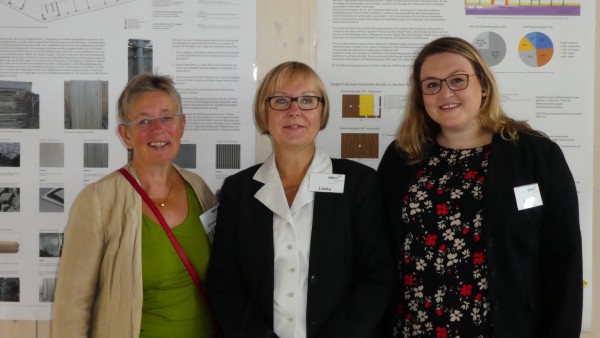
Successful cooperation
Susanne Korhammer (Tara Ingenieurbüro), Vera Litzka (Stadtwerke Neustadt) and Kim Maertel (Tara Ingenieurbüro), from left to right, are happy about the new work location.
New approach to construction and planning
Vision is needed to construct a new building consistent with the principles of the circular economy. The aim is not only to keep the energy consumption of the finished building as low as possible, the achievement of lower carbon emissions during construction, maintenance and disposal is also addressed in the planning phase.
TARA Ingenieurbüro developed the energy concept for the new building. Key component: the life cycle analysis. “For each component, we consider and verify which material and construction options will result in a building with fewer carbon emissions – for example, whether a massive interior wall should be made of sand-lime brick or wood,” explains Susanne Korhammer.
After a five-month planning period from November 2014 to March 2015, the ground-breaking ceremony was held in July 2016. Three different buildings will be constructed on 8,300 square meters of land – the new location for the 58 employees of the Neustadt Stadtwerke. In addition to the garage and a warehouse including workshops, the heart of the complex is the administrative building with control room, archive and staff cafeteria.
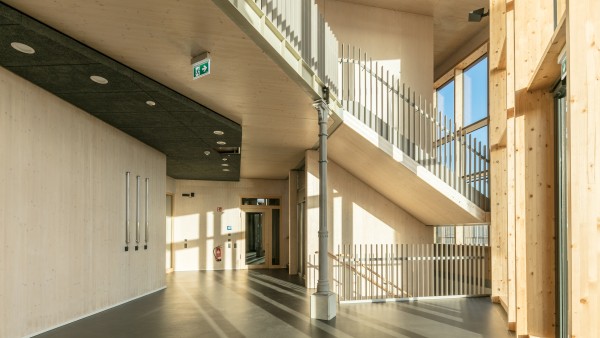
Second-hand
A historical support column from Karlsruhe has found a new home in the new build.
High energy supply standards
The well thought-out interior design is intended to contribute to a feeling of well-being: “We attached great importance to well-lit rooms with plenty of natural light. We also wanted a flexible concept, which means that all the walls between the offices are lightweight, and we can easily remove them later if our needs change. Open-plan offices, kitchenettes and copy and material rooms, for example, are located on the inside, the corridor runs around them and the individual offices are accessed from there. Thanks to partition walls made of aluminium and glass, natural daylight reaches all the way into the corridors,” Litzka explains vividly.
In a zero-emissions building, the annual energy consumed and generated must be equal. For the energy supply, a geothermal heat pump and a combined heat and power unit (CHP) were installed and photovoltaic systems were installed on the roof of all three buildings. Ventilation systems with heat recovery ensure comfortable temperatures inside the building. One outcome of the life cycle analysis was that instead of one large ventilation system, five smaller ones were installed – one for each fire prevention zone. This was not only cheaper and more carbon-efficient, it also accounted for the fact that we do not have a company in Neustadt that can service a large industrial ventilation system,” Vera Litzka said, explaining the decision. Long journeys for specialist workmen increase costs and negatively impact the carbon footprint.
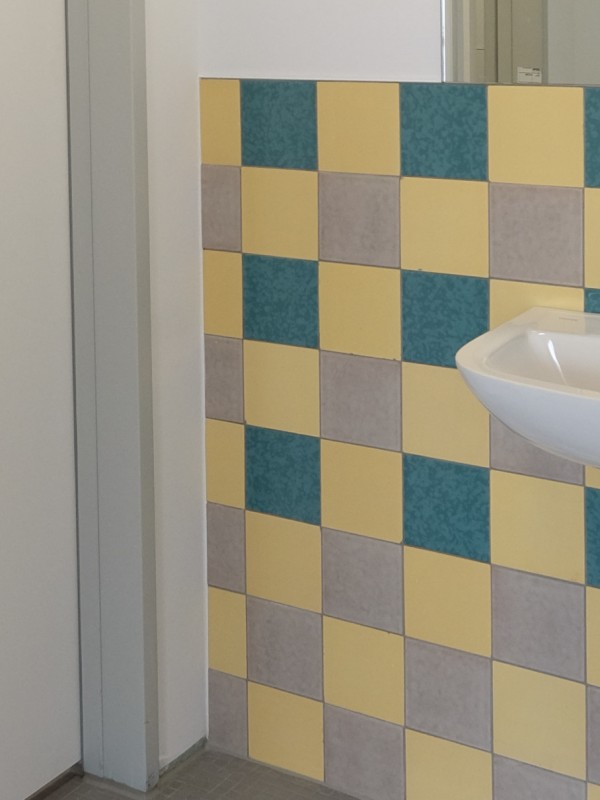
Second life
Used bathroom tiles were integrated into in the washrooms.
The ambitious construction project requires a lot of flexibility
If you need this kind of second-hand material you just have to know where to look: both abroad and in Germany, there is a market for used components, for example component marketplaces. “We found what we were looking for on a marketplace in Bremen,” says Litzka. This sounds simple at first, but also poses challenges, as Korhammer explains: “The process was as follows: procuring components, calculating costs, temporary storage, inviting tenders for installation throughout Europe and then installing the components with quality assurance.”
Plans have to be adjusted time and again. The used partitions, for example, were slightly lower than expected. The same applies to the technology: “We originally planned to install heat pumps, but then had the opportunity to buy a used CHP unit. Which meant we had to overhaul the energy concept. Everyone involved – from architects to system engineers – worked closely together on the project, otherwise this would not have been possible,” explains engineer Korhammer.
Full of daylight
The premises of the new administration building of Stadtwerke Neustadt are bright and airy. Big window elements provide for natural light.
Carpets made of fishing net and seaweed acoustic elements
The wood construction – 7,000 cubic metres of wood were employed – and the use of used components are also sustainable. The partition walls made of aluminium and glass are second-hand – they were previously installed in an office complex in Hamburg. The carpet is made of old fishing nets, recycled glass, known as foam glass gravel, serves as floor insulation, used bathroom tiles were integrated into the mirrors in the washrooms.
But that's not all: the acoustic walls in the conference rooms, which reduce the sound level and reverberation, are made of seaweed, among other materials. “The Baltic Sea is full of it, every morning the maintenance crews have to clear it from the beaches. This way, we can even benefit from the excess,” says Litzka, clearly satisfied. Another recycling highlight is a historical support column from Karlsruhe, which was used in the entrance area to the building. “We had to make careful preparations before it could be installed because it is a supporting element. But it was worth it.”
Funding for a project that exceeds standards
After a construction period of around two years, the Stadtwerke was able to move into the ultra-modern building complex at the beginning of October 2018. The building was put to the test: “I was expecting criticism because the move was viewed very sceptically beforehand,” revealed Vera Litzka. “We moved out of the city centre to a location on the outskirts – more precisely, to an industrial park close to where the city starts and the A1,” says Litzka.
But the concerns turned out to be unfounded. “The employees are happy. The old building was badly insulated, in the summer at an outside temperature of 25 degrees, it was practically unbearable on the upper floors because it was so warm. These problems are now a thing of the past.” There was also scepticism about the noise from the motorway and the A-road, which pass right by the building. But the triple glazing on the windows doesn't let any noise in. And since the ventilation can be turned on, we don't need window ventilation anymore.” Construction at the new site cost around 10 million euros. Support for financing was provided by the Deutsche Bundesstiftung Umwelt (DBU),which continues to support the project with energy monitoring, and by KfW, which provided around 4.2 million euros for the construction project under the IKK (energy-efficient construction) programme.
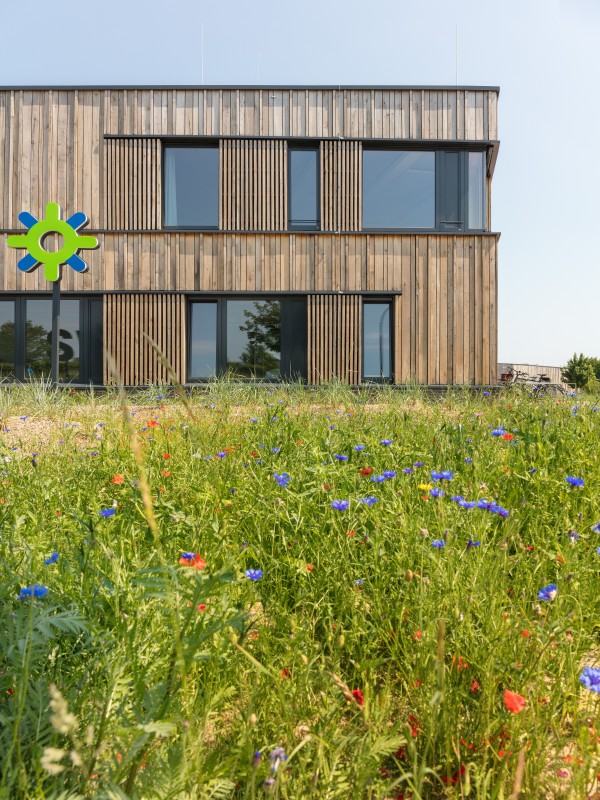
Sustainable construction
For the façade, wood was given preference as a renewable raw material.
“This construction project is a particularly impressive example of the role model function and innovative strength of the municipalities in the context of local energy system transition and of the fact that environmental protection and climate change mitigation don't have to be at odds with profitability,” says Janina Oest, Sales Coordinator of Infrastructure Financing at KfW. The engineer Korhammer puts it similarly: “The new administrative building is proof that design does not conflict with energy efficiency and sustainability. On the contrary: the building is trend-setting and also serves as a role model for other municipalities.”
The TARA Ingenieurbüro can provide concrete figures on sustainability: the building reduces carbon emissions by 29 per cent compared to a comparable conventional building: 24 per cent through the use of resource-efficient systems technology and renewable raw materials such as wood and 5 per cent through the reuse of building materials.
Comparison figures for energy consumption are not yet available. But that will change, as Litzka explains: “We are participating in a DBU research project, which includes energy monitoring for several years. To this end, we are installing electricity and heat meters to monitor energy consumption in the individual areas. This will provide data for the next few years to help us continuously optimise.”
Award for the innovative energy concept
In the “EnEff.Gebäude.2050” ideas competition organised by the German Federal Ministry of Economics and Energy, the Stadtwerke was awarded 30,000 euros in prize money for the new building. Reason: the project features a particularly innovative energy concept. It was also presented at the Tenth Climate and Energy Conference of the Schleswig-Holstein Municipal Day in November 2018 and was very well received by the 150 municipal representatives from all over Schleswig-Holstein.
Korhammer hopes that the new administrative building is not an isolated case, but sets standards for construction projects throughout Germany. “We are on the right track in terms of energy efficiency in the new building. But resource efficiency and sustainability need to be further developed. The new building of the Neustadt Stadtwerke is an impressive flagship project.”
Published on KfW Stories: Tuesday, 6 August 2019
The described project contributes to the following United Nationsʼ Sustainable Development Goals
Goal 7: Ensure access to affordable, reliable, sustainable and modern energy
Close to 80 per cent of the energy produced worldwide still comes from fossil fuel sources. Burning fossil fuels also generates costs for the health system due to air pollution and costs for climate-related damages that harm the general public, not just those burning the fuel.

All United Nations member states adopted the 2030 Agenda in 2015. At its heart is a list of 17 goals for sustainable development, known as the Sustainable Development Goals (SDGs). Our world should become a place where people are able to live in peace with each other in ways that are ecologically compatible, socially just, and economically effective.

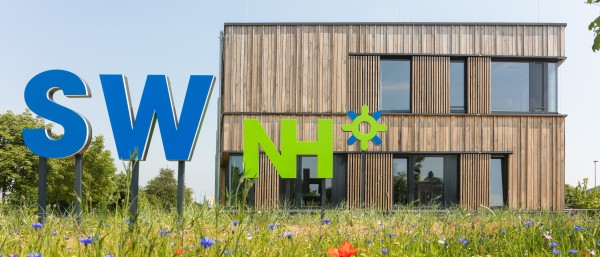
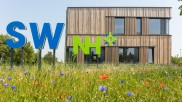
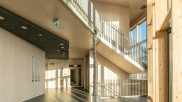
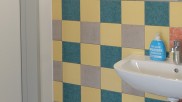
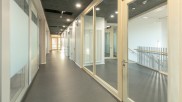
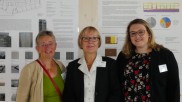
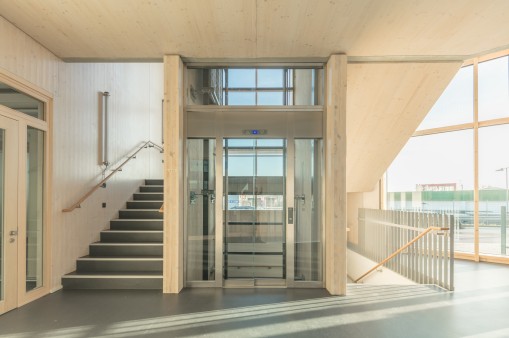
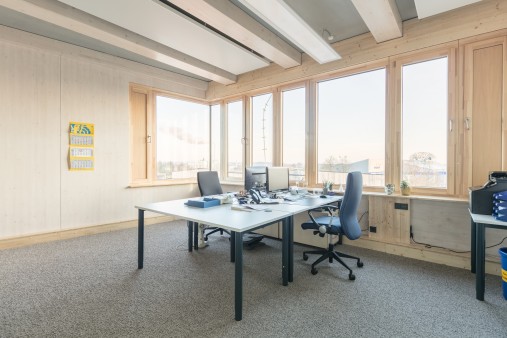
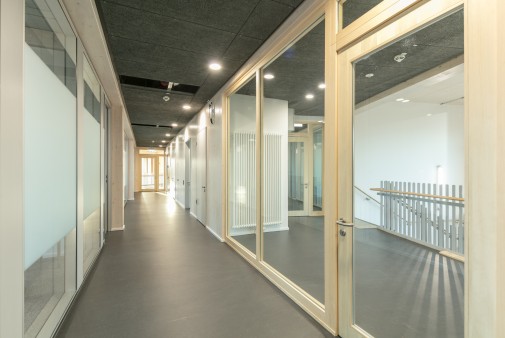



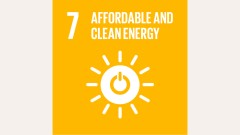
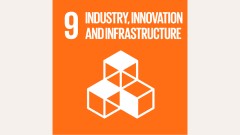
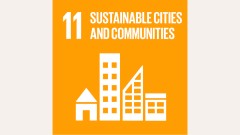
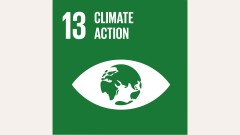
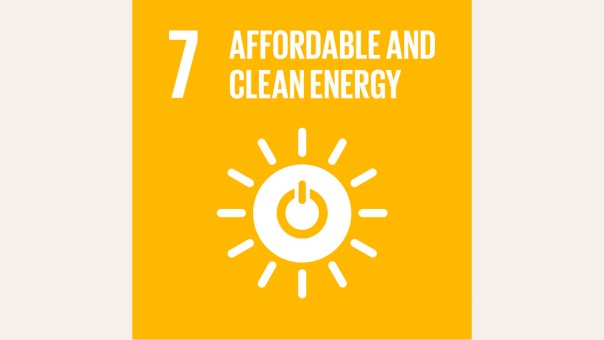
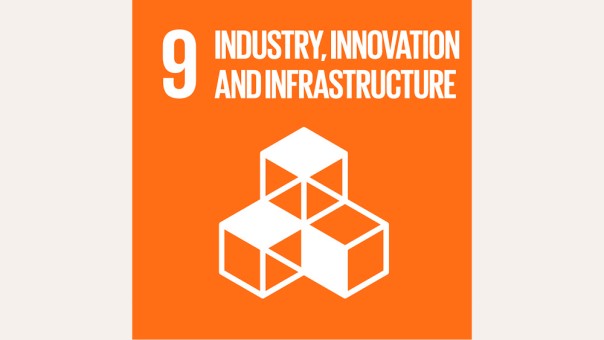
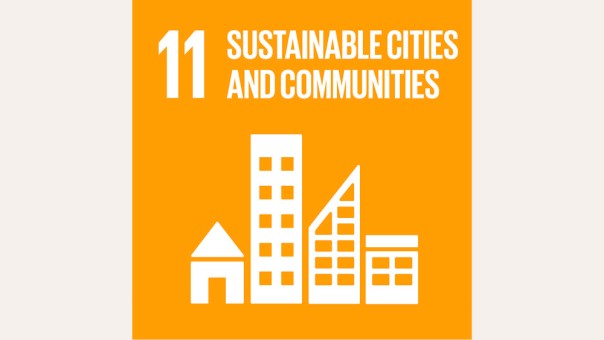
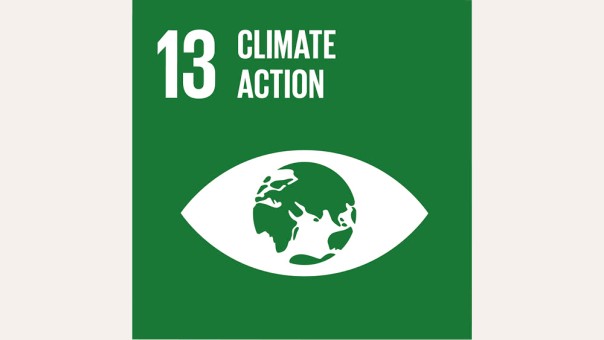
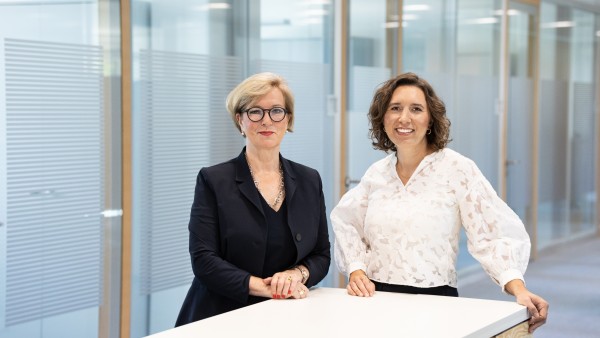
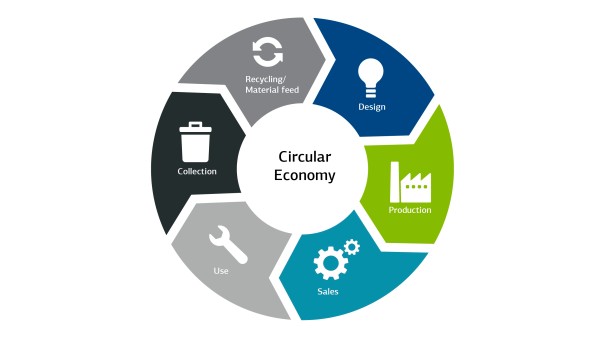
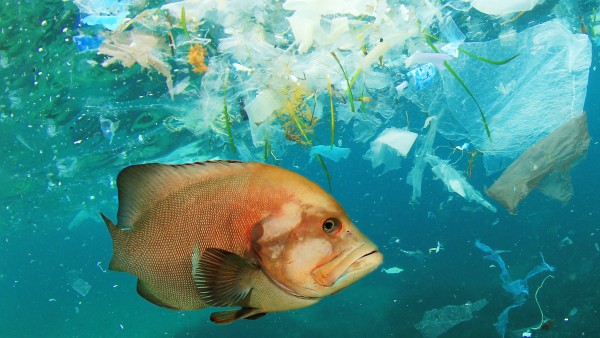
Data protection principles
If you click on one of the following icons, your data will be sent to the corresponding social network.
Privacy information